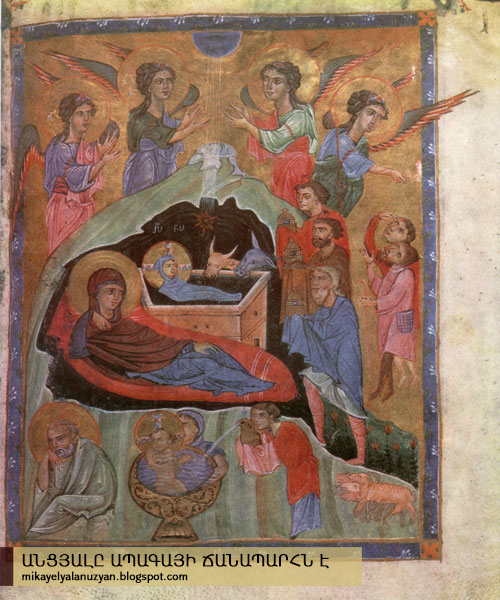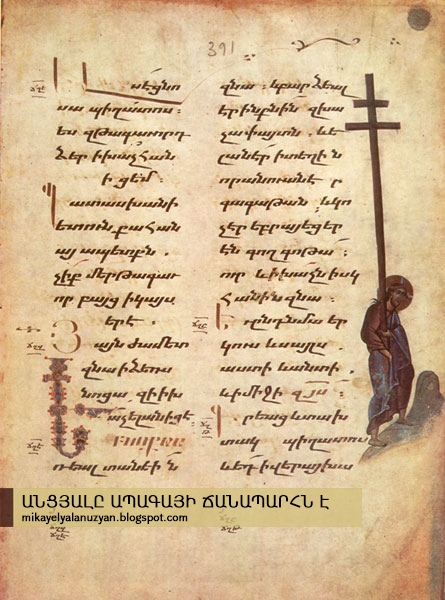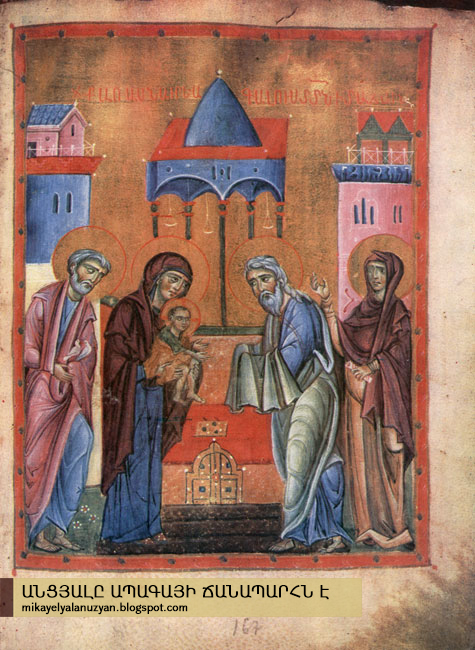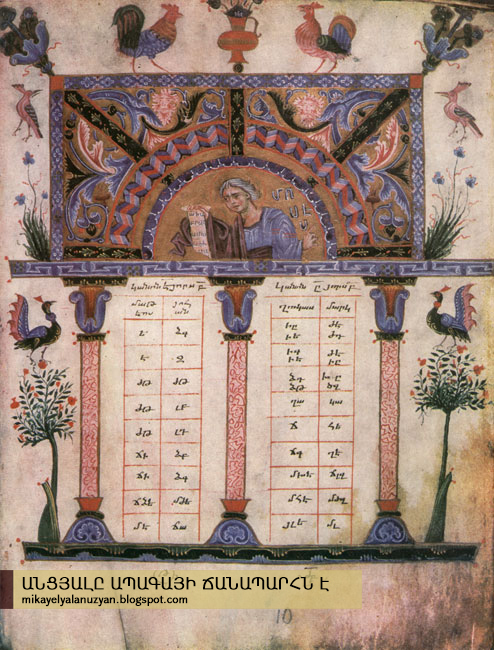With the appearance of Toros Roslin, the art of Armenian book illustration and especially 13th c. Cilician miniature painting was characterized by a new aesthetical comprehension of the world and new ideas. In his miniature paintings Toros Roslin concentrated the artistic experiences of the past, both of his own and of other peoples; he opened new horizons and opportunities for future painters.

Roslin's cultural heritage reveals moods formerly unknown, new interpretations of old traditions, themes and figures.
The artist's attention is concentrated on man and his restless nature in particular. Roslin's figures, externally quiet, reflect the spiritual trouble of medieval man, his anxieties, his inner world, the inexplicable ups and downs of his apparently imperceptible emotions.
A more significant innovation in Roslin's art is the individualization of human faces. In medieval art the distinct, differing from each other and non-idealized portrayal of the human face begins in the second half of the 13th cent. In this sense, Roslin, the great master, must be considered among the more progressive artists of that period.
The fundamental characteristics of Roslin's style originate from 11- 12th c. artistic sources.
 Very little is known concerning Roslin's biography. The dates of his birth and death have not been preserved; we know, however, that the first manuscript which has comedown to us bearing his signature is dated 1256, while the last one is of the years 1267-1268. Seven splendidly ornamented manuscripts of this talented artist have reached us, which
are preserved in the depositories of Yerevan, Jerusalem and Baltimore (USA). Besides these remarkable works of his, two unsigned manuscripts and one fragment are likewise attributed to him.
Very little is known concerning Roslin's biography. The dates of his birth and death have not been preserved; we know, however, that the first manuscript which has comedown to us bearing his signature is dated 1256, while the last one is of the years 1267-1268. Seven splendidly ornamented manuscripts of this talented artist have reached us, which
are preserved in the depositories of Yerevan, Jerusalem and Baltimore (USA). Besides these remarkable works of his, two unsigned manuscripts and one fragment are likewise attributed to him.
 The fact that all the above mentioned codexes were copied and illustrated in Hromkla (Cilicia) leads us to conclude that Roslin worked at that scriptorium.
The fact that all the above mentioned codexes were copied and illustrated in Hromkla (Cilicia) leads us to conclude that Roslin worked at that scriptorium.
The artists Kirakos and Hovhannes, who lived in Hromkla in the first half of the 13th c. and whose illustrations have much in common with those of Roslin, are considered to have been his teachers.
 The Armenian king Levon III (1270-1289) and the catholicos Costandin of Bartsrberd (1221-1267) were patrons of Toros Roslin and ordered him to prepare manuscripts. Roslin's pupils assisted him in his work but their names have not been preserved.
The Armenian king Levon III (1270-1289) and the catholicos Costandin of Bartsrberd (1221-1267) were patrons of Toros Roslin and ordered him to prepare manuscripts. Roslin's pupils assisted him in his work but their names have not been preserved.
Each relic in Roslin's heritage had its „Odyssey", its life of temptations and calamities. The colophons of the manuscripts tell of their various transportations, redemptions, captivities, of their miraculous deliverances.
 For hundreds of years the later owners of Roslin manuscripts have left records begging that those treasures be preserved and treated piously and delicately; we have also evidences testifying the people's high estimation and admiration of the famous artist's masterpieces.
For hundreds of years the later owners of Roslin manuscripts have left records begging that those treasures be preserved and treated piously and delicately; we have also evidences testifying the people's high estimation and admiration of the famous artist's masterpieces.
Roslin's manuscripts have existed for centuries and their illustrations are amazing even for the 20th century observer, thus extending the fame of the Armenian artist and Armenian art all over the world.
LEVON CHOOKASZIAN

Roslin's cultural heritage reveals moods formerly unknown, new interpretations of old traditions, themes and figures.
The artist's attention is concentrated on man and his restless nature in particular. Roslin's figures, externally quiet, reflect the spiritual trouble of medieval man, his anxieties, his inner world, the inexplicable ups and downs of his apparently imperceptible emotions.
A more significant innovation in Roslin's art is the individualization of human faces. In medieval art the distinct, differing from each other and non-idealized portrayal of the human face begins in the second half of the 13th cent. In this sense, Roslin, the great master, must be considered among the more progressive artists of that period.
The fundamental characteristics of Roslin's style originate from 11- 12th c. artistic sources.
 Very little is known concerning Roslin's biography. The dates of his birth and death have not been preserved; we know, however, that the first manuscript which has comedown to us bearing his signature is dated 1256, while the last one is of the years 1267-1268. Seven splendidly ornamented manuscripts of this talented artist have reached us, which
Very little is known concerning Roslin's biography. The dates of his birth and death have not been preserved; we know, however, that the first manuscript which has comedown to us bearing his signature is dated 1256, while the last one is of the years 1267-1268. Seven splendidly ornamented manuscripts of this talented artist have reached us, which The fact that all the above mentioned codexes were copied and illustrated in Hromkla (Cilicia) leads us to conclude that Roslin worked at that scriptorium.
The fact that all the above mentioned codexes were copied and illustrated in Hromkla (Cilicia) leads us to conclude that Roslin worked at that scriptorium.The artists Kirakos and Hovhannes, who lived in Hromkla in the first half of the 13th c. and whose illustrations have much in common with those of Roslin, are considered to have been his teachers.
 The Armenian king Levon III (1270-1289) and the catholicos Costandin of Bartsrberd (1221-1267) were patrons of Toros Roslin and ordered him to prepare manuscripts. Roslin's pupils assisted him in his work but their names have not been preserved.
The Armenian king Levon III (1270-1289) and the catholicos Costandin of Bartsrberd (1221-1267) were patrons of Toros Roslin and ordered him to prepare manuscripts. Roslin's pupils assisted him in his work but their names have not been preserved.Each relic in Roslin's heritage had its „Odyssey", its life of temptations and calamities. The colophons of the manuscripts tell of their various transportations, redemptions, captivities, of their miraculous deliverances.
 For hundreds of years the later owners of Roslin manuscripts have left records begging that those treasures be preserved and treated piously and delicately; we have also evidences testifying the people's high estimation and admiration of the famous artist's masterpieces.
For hundreds of years the later owners of Roslin manuscripts have left records begging that those treasures be preserved and treated piously and delicately; we have also evidences testifying the people's high estimation and admiration of the famous artist's masterpieces.Roslin's manuscripts have existed for centuries and their illustrations are amazing even for the 20th century observer, thus extending the fame of the Armenian artist and Armenian art all over the world.
LEVON CHOOKASZIAN
Комментариев нет:
Отправить комментарий